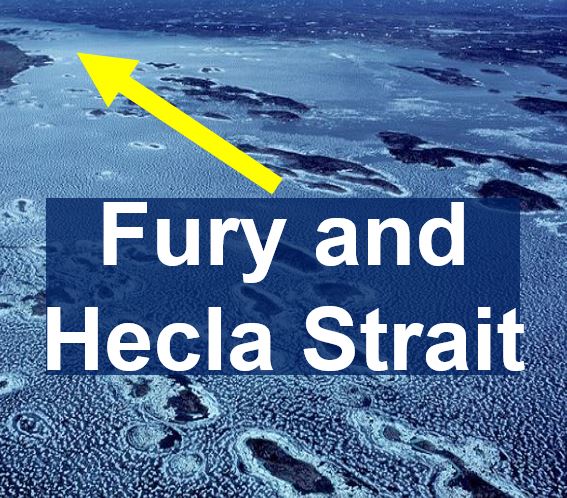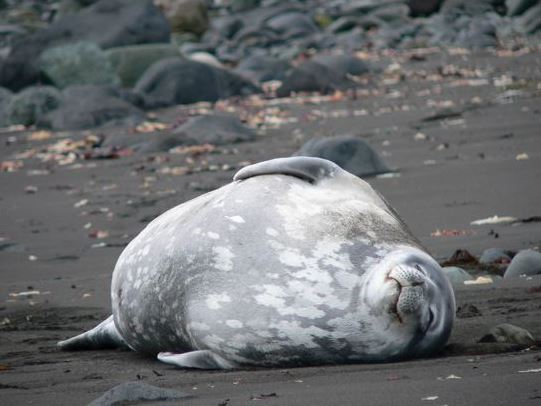A mysterious pinging sound has animals scared in the Arctic, locals concerned, and experts and military personnel baffled – nobody can explain where this persistent noise is coming from. The large area of water and ice in northern Canada should be teeming with sea mammals – nobody understands why they have suddenly mostly gone. The pinging is probably scaring them away.
Canada’s armed forces are investigating the enigmatic phenomenon. An air force plane has carried out a number of multi-sensor searches throughout the area where the pinging was detected by humans.
We cannot hear the sound with our ears, but our equipment picks it up. Experts say that whales and some other creatures are probably able to hear it.
 A CP-140 Aurora, a long range aircraft belonging to the Royal Canadian Air Force, has been surveying the area carefully and has so far not detected any unusual sounds. (Image: rcaf-arc.forces.gc.ca)
A CP-140 Aurora, a long range aircraft belonging to the Royal Canadian Air Force, has been surveying the area carefully and has so far not detected any unusual sounds. (Image: rcaf-arc.forces.gc.ca)
So far, everybody involved in trying to determine what the pinging sound is or where it comes from is at a loss to explain the ‘acoustic anomalies’.
Pinging sound coming from under water
Pay Quassa, a Nanavut Legislative Assembly member, explained:
“The sound that has been heard in the area seems to be emitted from the seabed and under water.”
“Our constituents as well as hunters and boaters have reported that the area in question is almost devoid of sea mammals and that hunting has been poor in the area for quite some time.”
Quassa said he had spoken to several people who detected the sound with their audio equipment.
A sailing boat that was navigating through the area during the summer confirmed the puzzling sound with onboard sonar devices and immediately informed the community.
 Boats with audio equipment detected the sound – sea mammals appear to be scared away by it. However, when the Royal Canadian Air Force went to investigate, it did not hear a peep. (Image: flickr.com/photos)
Boats with audio equipment detected the sound – sea mammals appear to be scared away by it. However, when the Royal Canadian Air Force went to investigate, it did not hear a peep. (Image: flickr.com/photos)
Regulatory agencies, as well as the Nanavut Research Institute informed that nobody had applied for a license for a sound-emitting device for the region recently. Premier Peter Taptuna’s office informed the Department of National Defence in Ottawa about the bizarre noises.
It is now a question of allowing the Department of National Defence to carry out a comprehensive review and report its findings, Quassa said.
Pinging sound not from wildlife
Some locals have suggested that perhaps a sea mammal or other creature may be emitting the sound. However, whale experts and other marine zoologists believe this is highly unlikely.
Senior liaison officer at the Department of National Defence, Evan Koronewski, said:
“The Department of National Defence has been informed of the strange noises emanating in the Fury and Hecla Strait area, and the Canadian Armed Forces are taking the appropriate steps to actively investigate the situation.”
The crew of the military aircraft that is surveying the area said the only wildlife they detected were six walruses and two pods of whales.
A spokesman for the Department of Defense in Ottawa said that nobody has any idea what the pinging noise is or its origin. Locals say the noise can be heard through the hulls of ships.
 The ping sound was heard at Fury and Hecla Strait in northern Canada. The Canadian military believes the noises have stopped. (Image: Google Map)
The ping sound was heard at Fury and Hecla Strait in northern Canada. The Canadian military believes the noises have stopped. (Image: Google Map)
The Canadian aircraft, a CP-140 Aurora, observed no unusual sounds during a sweep of Fury and Hecla strait. According to the crew, during Operation LIMPID, an acoustic search that lasted 1.5 hours detected no anomalies. They added that they did not identify any surface or subsurface contacts.
People who have detected the sound with their audio equipment described it as a ping, hum or beep. The pinging sound has been picked up by equipment throughout the summer in Hecla Strait and Fury, a narrow channel (2 to 20 km) of water situated in the Qikiqtaaluk Region of *Nunavut, Canada. It is located roughly 120 kilometres northwest of the hamlet of Igloolik, between the Melville Peninsula to the south and Baffin Island to the north.
* Nanavut, with a population of approximately 32,000 people, covering an area of 2,038,722 km2 (787,155 sq mi), is the newest, largest, northernmost, and least populous territory of Canada.
 A seal on Baffin Island. Why have they all disappeared? (Image: uk.pinterest.com)
A seal on Baffin Island. Why have they all disappeared? (Image: uk.pinterest.com)
Why have the sea mammals gone?
Hecla Strait and Fury, which consists of ice surrounding an open area of water, is used by local people for fishing and hunting in the summer and winter. It is famous for its abundant wildlife.
Known as Aukkannirjuaq in Inuktitut, the Fury and Hecla Strait area is classified as a polynya – an area of warm current which has large ice-free areas (surrounded by ice), even in winter. It is home to a rich diversity of fish and other creatures, including whales, walruses and seals.
Local hunters said they have never seen the area as devoid of whales, walruses and other marine mammals as it is now. Apart from the sighting by the military aircraft, no human on the ground or on a boat has seen a bowhead whale or a seal in the area this year.
Proposed explanations for pinging sound
Canadian media outlets are full of contributions by people offering explanations for the pinging noise, such as:
– Military: perhaps a NATO power is testing some kind of military equipment, such as a new type of sonar or submarine. However, according to the Canadian military, no submarines or other armed forces equipment has been in operating in the area.
– Greenpeace: is the environmental protection organization deliberately trying to scare away the sea mammals in order to save their lives, i.e. moving them far away from human hunters? Greenpeace is adamant that it has nothing to do with these bizarre sounds.
– Mining: sometimes companies carry out sonar surveys to determine whether target minerals are present. Local mining companies say that none of them has carried out any surveys in the area. They added that had outside companies been operating in the area, they would have known about it.
– Extraterrestrials: a sizable number of alien enthusiasts and UFO hunters are convinced that the sound ‘is not from this world’. They suggest it could be a beacon telling a distant advanced civilization thousands of light-years from here that all is fine, or it could be sending them an encrypted updated report regarding life on Earth.
